EUROCARE-4 summary results on cancer survival in Europe
1. EUROCARE-4 Survival of cancer patients diagnosed in 1995 - 1999
Age-standardized five-year relative survival (%) with mean European survival, for cancers of the breast, colorectal and stomach, skin melanoma and non-Hodgkin lymphoma, by country. Both sexes

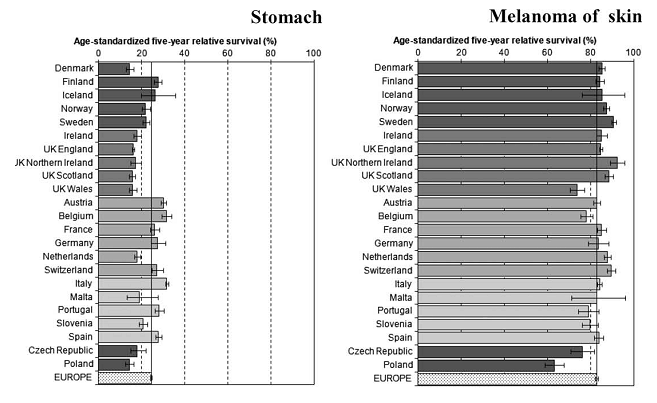
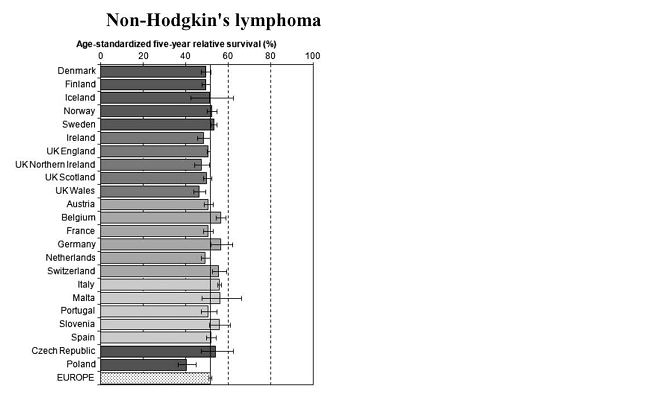
2. Survival of European children and young adults with cancer diagnosed 1995 - 2002
Figure: 5-year survival for all cancer combined in European children and adolescents/young adults
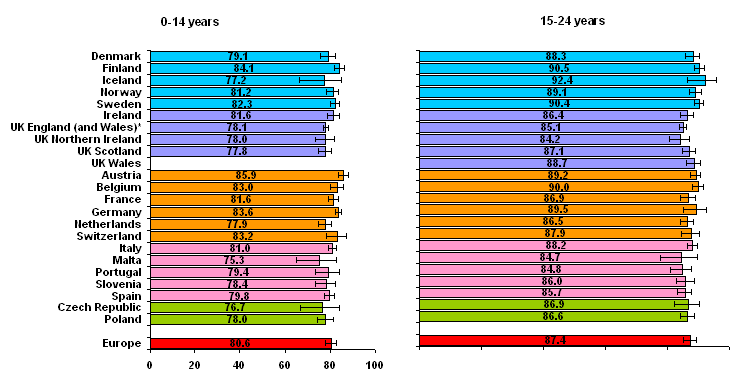
* UK England and Wales together for 0-14 years and England only for 15-24 years of age
3. Long-term survival expectations of cancer patients in Europe in 2000-2002
In EUROCARE 4, for the first time, period estimates (PE) of survival expectations of cancer patients diagnosed in the early 21st century were derived. The following tables shows expected 1-, 5-, and 10-year relative survival of cancer patients diagnosed in 2000-2002 by cancer site for Europe, adjusted to the European standard cancer population.

ALL, acute lymphoblastic leuk; CLL, chronic lymphocytic leuk AML, acute myeloblastic leuk ; CML, chronic myelocitic leuk
4. The cancer survival gap between elderly and middle aged patients in Europe is widening
Figure 1 - 1-year and 5-year relative survival (%) from diagnosis by sex and cancer site for elderly (70-84 years) and middle aged (55-69 years) cancer patients in 2000-2002, and 5-year relative survival conditional on surviving 1-year. Relative excess risk of death for the elderly (70-84) compared with middle aged adults (55-69 years) (weighted European pool; period analysis method).
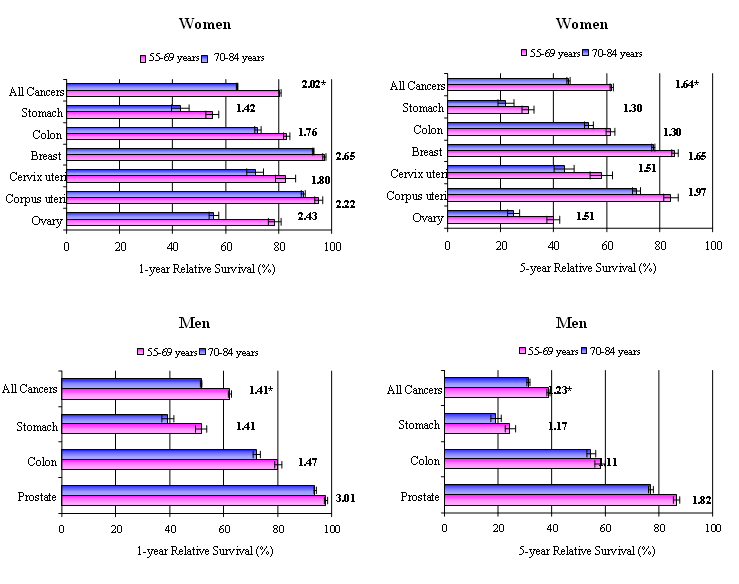
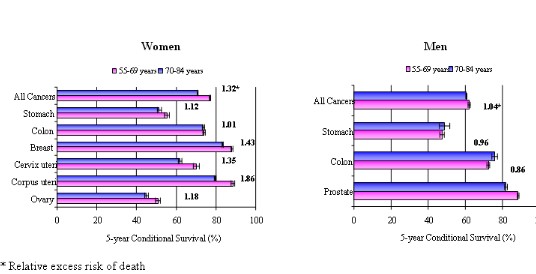
5. The advantage of women in cancer survival
Women have a longer life expectancy than men and better survival of chronic diseases like cardiovascular disease and cancer. Neither biological nor cultural factors have been clearly established as responsible for the longevity and survival advantage of women.
We analysed 1.6 million population-based cancer cases (26 cancer sites, excluding sex-specific sites, and breast) from 23 countries participating in the EUROCARE-4, to investigate the role of sex in cancer survival according to age at diagnosis, site, and European region. For 15 sites (salivary glands, head and neck, oesophagus, stomach, colon and rectum, pancreas, lung, pleura, bone, melanoma of skin, kidney, brain, thyroid, Hodgkin disease and non-Hodgkin’s lymphoma) age- and region-adjusted relative survival was significantly higher in women than men. By multivariable analysis, women had significantly lower relative excess risk (RER) of death for the sites listed above plus multiple myeloma. Women significantly had higher RER of death for biliary tract, bladder and leukaemia only. For all cancers combined women had a significant 5% lower RER of death. Age at diagnosis was the main determinant of the women’s advantage, which, however, decreased with increasing age, becoming negligible in the elderly, suggesting that sex hormone patterns may have a role in women’s superior ability to cope with cancer.

Figure. Non age adjusted (crude), age adjusted, and age and case-mix adjusted in the European Pool; and age, case-mix and region adjusted 5-year relative survival for all cancers combined in Europe. The figure above synthesises results for all cancers combined in univariate analysis. For women, 5-year relative survival was 42.7% in crude analyses and 42.4% when the age, case-mix and region adjustment was performed; on the other hand, for men, survival figures were 37.8% in crude data and 39.7% when the age, case-mix and region adjustment was considered. Thus, after all the performed adjustments the female advantage reduced to 2.7 percentage points from 4.9 percentage points when crude data were compared.
6. Multiple tumours in survival estimates
The figure synthetically presents the differences between age-standardised 5-year survival estimates when including first and all subsequent cancers, compared to those with first cancer only. The y axis reports the difference observed across the participating European cancer registries. Differences where put in relation with the percentage of multiple primary tumours recorded by the cancer registries. The amount of bias (difference between survival estimates including or not multiple primaries) is roughly proportional to the proportion of multiple primaries.

Differences in age-standardised 5-year survival (First & Multiples tumours - First only) by percentage of multiple tumours among the EUROCARE-4 Cancer Registries (dotted line=linear trend women, continuous line=linear trend for men).
7. The cure of cancer: A European perspective
Colon and rectum cancers: proportion of cured patients (horizontal axis) and life expectancy of fatal cases ( vertical axis) in adult European patients (age 15-99 years) diagnosed from 1988 to 1999 by a pool of 49 European cancer registries.
Changes with age of diagnosis (15-44, 45-54, 55-64, 65-74, and 75-99 years) and with diagnosis period (1988-90, 1991-93, 1994-96, and 1997-99) are also reported.
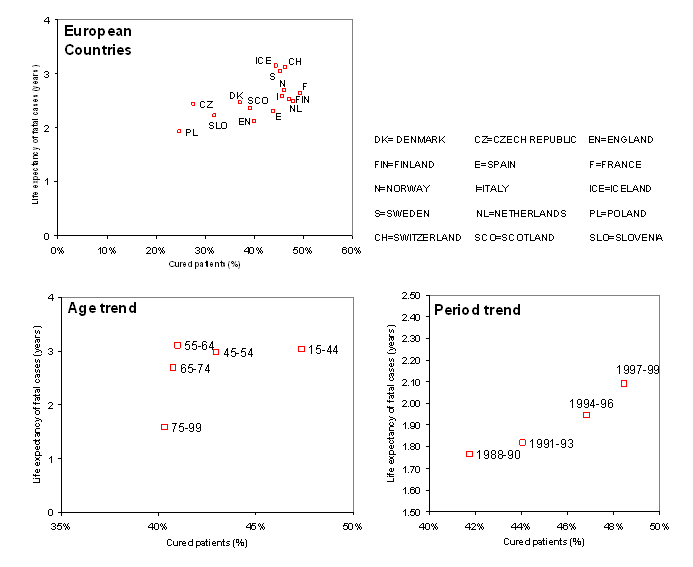
For colon and rectum cancers the average time to death for fatal cases was estimated between two and three years, and the proportion of cured cases ranged from 25% to 49%. Country-specific colon and rectum cancer survival fell into two broad patterns: (a) countries with homogeneous (between 2 and 2.4 years) fatal case survival times and large differences (25% to 40%) in the proportion of cured cases; and (b) countries with more variable fatal case survival times (2-3 years) and higher proportions of cured cases (44%-49%). As regards the influence of age at diagnosis on the European pool of colon and rectum cancer cases, 47.4% of patients aged 15-44 years were estimated cured, while those aged 55 or more had similar proportions of cured cases (between 40% and 42%) to those aged 45-54 (43%). For the 58-60% of fatal cases, survival time was constant (at about three years) for younger patients (up to age 64) and decreased to 1.6 years in old patients (75-99 years). Colon and rectum cancer survival improved over time in the European pool, the proportion cured increased from about 42% in 1988-1990 to about 48% in 1997-1999.


